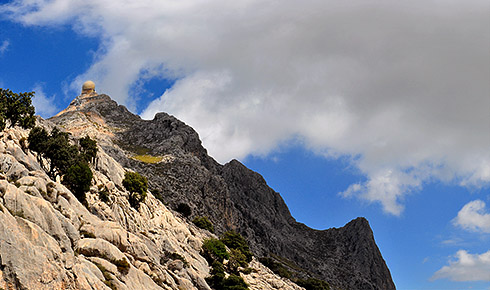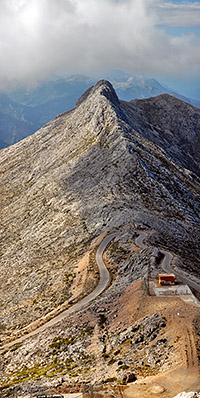Antoni Parietti and Puig Major funicular railway
The concept that most people have nowadays of nature conservation is not the same as that of our grandparents. Demographic pressure on the island has made man responsible for distorting and altering the landscape. In the early 20th century, when the population was much lower and there were hardly any motor vehicles, Mallorca was totally unspoilt, with excellent prospects as a high-quality tourist destination, providing that better access was ensured to natural spaces that we today try to protect.
The Serra de Tramuntana is a traditionally less accessible natural space, hence its better state of conservation. Having said that, in the first half of the 20th century, projects were often conceived to improve access to the Serra de Tramuntana for tourism purposes. They can be attributed to a different kind of mentality and they transformed the landscape in a way that would no doubt be inconceivable today, although they also brought Mallorcans and tourists into closer contact with certain places that would otherwise be impossible to reach.

One of the most tenacious figures in striving to improve access to the Serra de Tramuntana was engineer Antoni Parietti Coll
One of the most tenacious figures in striving to improve access to the Serra de Tramuntana was engineer Antoni Parietti Coll (Palma, 1899-1979). Parietti was the head of the Provincial Government's Engineering and Roads Department, as well as being the chairman of Foment del Turisme, an organization for the promotion of tourism. As part of the Local Roads Plan, aimed at adapting existing roads for use by motor vehicles, he personally supervised two major public works projects in the Serra de Tramuntana: the 1925 road between Port de Pollença and Formentor, which allowed Adan Diehl to build his famous hotel there, and the 1933 road to Sa Calobra. Both were built for tourism purposes, not to unite existing towns and villages but to offer visitors access to two unique spots that have become famous precisely because of these roads. With our more protectionist mentality, the plan to build them would most likely be impossible now. We must also remember that, without them, Sa Calobra and Formentor would not be the two big tourist attractions that they are today. Isn't that a paradox?
Antoni Parietti's real dream was nonetheless a completely different project: to improve access to Puig Major by creating a funicular railway that would link Cals Reis, where the Sa Calobra road begins, to a point close to the summit at an altitude of 1,400 metres. The aim was to build an astronomical observatory on Puig Major, facilities for snow sports, and a restaurant. The project was presented at the Teatre Principal in 1934, arousing substantial popular support, after permission had been granted by the Ministry of Public Works. In June 1936, work began on the bottom platform at Cals Reis, although it was interrupted one month later when the Spanish Civil War broke out.
Parietti did not give up and in 1939 he tried to restart the project with the German firm Bleichord-Zueg, a collaborative relationship that was interrupted by the Second World War. In the 1950s, he managed to get permission to build a toll road but, under the 1953 treaty between the Franco Government and the United States on military bases in Spain, the top of Puig Major was converted into an American radar base, going on to become jointly run in 1963. The Spanish Air Force took advantage of Parietti's project to build the existing road up to the military installations.
To install radars on Puig Major, the mountain was lowered by 5 metres and the two domes that protect the radars were built, replaced in 2005 by just one, which Mallorcans and visitors can see on the highest tip of the Serra de Tramuntana.
Today, under an agreement between the Government of the Balearic Islands and the Spanish Ministry of Defence, the restricted area with the military installations has been transformed into a botanical observatory for the conservation of the Serra de Tramuntana's most unique species, some of which are endemic. The project to build a funicular railway is a symbol of another time and a very different mentality.
Text by Jordi Martí
Translated by Rachel Waters
Did you know that...
Work started on the construction of the Sa Calobra road in 1928 and it ended six years later. It was a technical feat for the time. A difference in altitude of over 800 metres had to be overcome, using 12 kilometres of winding road. The most difficult stretch was the 270º bend known as "Nus de la Corbata". In total, over 31,000 cubic metres of rocks and earth had to be moved. The terraced walls on which the road rests were built by hand. In 2007, the last labourer to work on the construction of the road died in Selva.
Bibliography

Many publications can be found on the subject of American military bases in Spain, with direct or indirect references to Puig Major radar base. Two outstanding examples are Las bases norteamericanas en España by Eduardo Chamorro and Ignacio Fontes (1976) and Los pactos secretos de Franco con Estados Unidos. Bases, ayuda económica, recortes de soberanía by Ángel Viñas (1981). An article by Lluís Úbeda Queralt, entitled 50 años de bases militares, can also be found on the Internet.
The name that is missing in publications is that of engineer Antoni Parietti, and only the local press contains the occasional article about him. A special mention should be made of articles by Laura Jurado in El Mundo (22/9/2009), Gabriel Rodas in Diario de Mallorca (19/4/2009) and Joan Vicens in Sa Veu de Sóller (3/7/2009), all written round about the 75th anniversary of the presentation, in Palma, of the Puig Major funicular railway.




